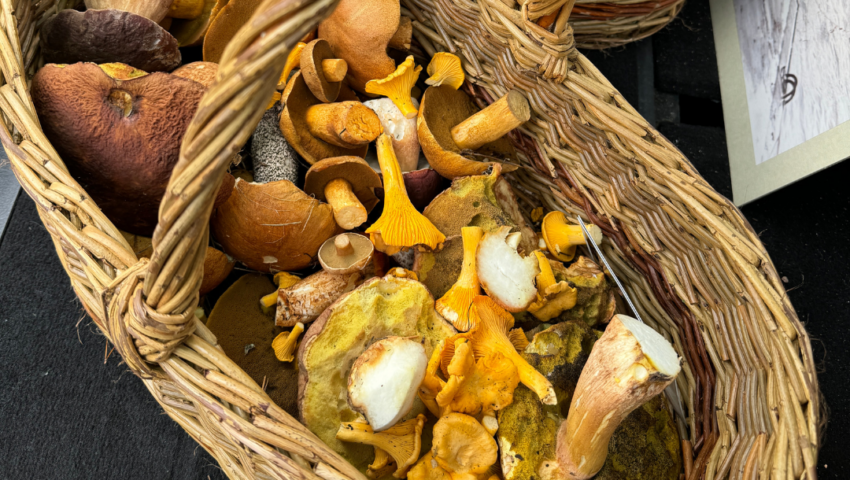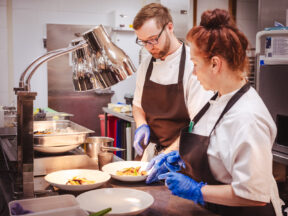Blogs
Foraging free, seasonal, and delicious food

Foraging
I love nothing more than getting out into the wild and foraging for free, seasonal, and delicious food. This connects you with both the season and the land, and provides free but well earned food! Unless you have a shotgun and a fishing rod to hand, lets start with the basics.
Ceps
-
Commonly known as – Penny Bun, Porcini
-
Scientific name – Boletus edulis
-
Season – Mid-Summer to Mid-Autumn
-
Habitat – Widespread particularly across Europe, North America, and
parts of Asia
This item I will, regardless of time, go out and hunt for.
Selecting and cleaning
The perfect cep mushrooms should have a smooth brown top. The texture should be firm, the gills white to cream in colour. It’s definitley worth cutting them vertically through the centre to ensure there are no maggots infesting it! This often happens if left in the ground too long. If needed, clean the ceps by carefully removing any soil and washing gently with cold water.
Preserving
Slice your foraged mushrooms thinly and dehydrate them overnight at 50°C with plenty of air circulation. These dried specimens can be kept in an airtight container for months. They can be used to add depth and richness to sauces and purees, powdered to dust over dishes, and even married with bitter chocolate.
Taste and cooking
I love the majestic look of the cep.
Its firm poise and illustrated structure amounts to a magnificent mushroom that yields the most wonderful woodland aroma. When fresh, the cep can be sliced raw, seasoned and eaten as such – delicious in itself.
Otherwise, cut it in half, score gently in a criss-cross fashion, and fry in a pan of hot olive oil and a knob of butter, adding garlic and thyme to the pan and allowing the mushroom to colour well before serving on toast.
Generally, ceps go well with red meat and robust fish such as brill and turbot. They’re good with eggs, and of course sing when paired with buttery pasta dishes.
My absolute favourite way to cook ceps is to slice them across the face, lay them on a plate spread out, season with salt and pepper, lightly grate parmesan over the top, drizzle with good olive oil and place into a hot oven for 3 minutes. When served over a salad or risotto, for me there is no finer mushroom.
Cooking with the flavours of an English county garden
Sounds romantic hey… but this is an area we are exploring with great excitement, as we turn each page a new chapter unfolds. This is a story of our recent works.
There are those of us that love wild food foraging, of which I am one, but I am relatively limited to my mushroom hunting, elderflower for cordial and the odd patch of wild garlic in April time – these excite me as a chef, and I love cooking with them. But with my love of gardening and plants I began to look deeper into the flavour profiles of an English garden and explore the possibilities of working with infusions and simple flavour extractions of plants, flowers and herbs – the plants that we can commonly grow ourselves at home.
Tomatoes
The best example was born out of a desire for our turbot dish at Trinity to be bursting with aromatic tomato flavour. Actual tomatoes used in the dish added depth and acidity but not much perfume.
So, we set about cutting the leaves from tomatoes in a greenhouse to capture that greenhouse flavour and baked our turbot with the leaves, wine and some small tomatoes that had been gently dried with fresh lavender. The cooking liquid that this dish omits allows us to emulsify a sauce that you simply couldn’t make another way – it is intoxicatingly tomatoey!
Figs
On the simpler end of the spectrum, we infuse cream and milk withfresh fig leaves and use this to make ice creams, chocolate ganache, and even a chocolate tart. I made this recently using Islands 85% chocolate.
Peaches
The leaves of plants can bring a whole new level of flavour. A good example is how we use peach tree leaves to infuse crème brûlée. We also use tiny amounts of cyanide that can be found in the kernel of most stone fruits, to make a granita. This is where that sweet gentle marzipan flavour comes from. Not harmful in sensible quantities.
Roses
We have started to harvest our own rose petal essence, which, believe it or not, is actually quite simple. Take the heads from ten or twelve nice, fragrant, (in bloom) open roses – I use tea roses. Place the petals in a shallow pan, place a ramekin in the centre and add just enough cold water to cover. Put a lid on top inverted so that you can fill this with ice.
Position over a low heat for 10 minutes and the condensation inside will drip into the ramekin and produce a totally natural rose water. This is excellent for meringues and fruit coulis or even in your gin and tonic!
Elderflower
We use elderflower when in bloom for syrups and vinegars. Also allow them to develop and become elderflower capers which can be pickled, or left to become elderberries of course. We find uses for plants such as hibiscus, lavender, peach leaves, fig leaves, rose, nasturtium (which makes great oil) marigold and chamomile and that’s just the beginning. I may start a farm purely for English botanical plants that can enrich our dishes and our lives… foraging is so last year.
Happy cooking.




